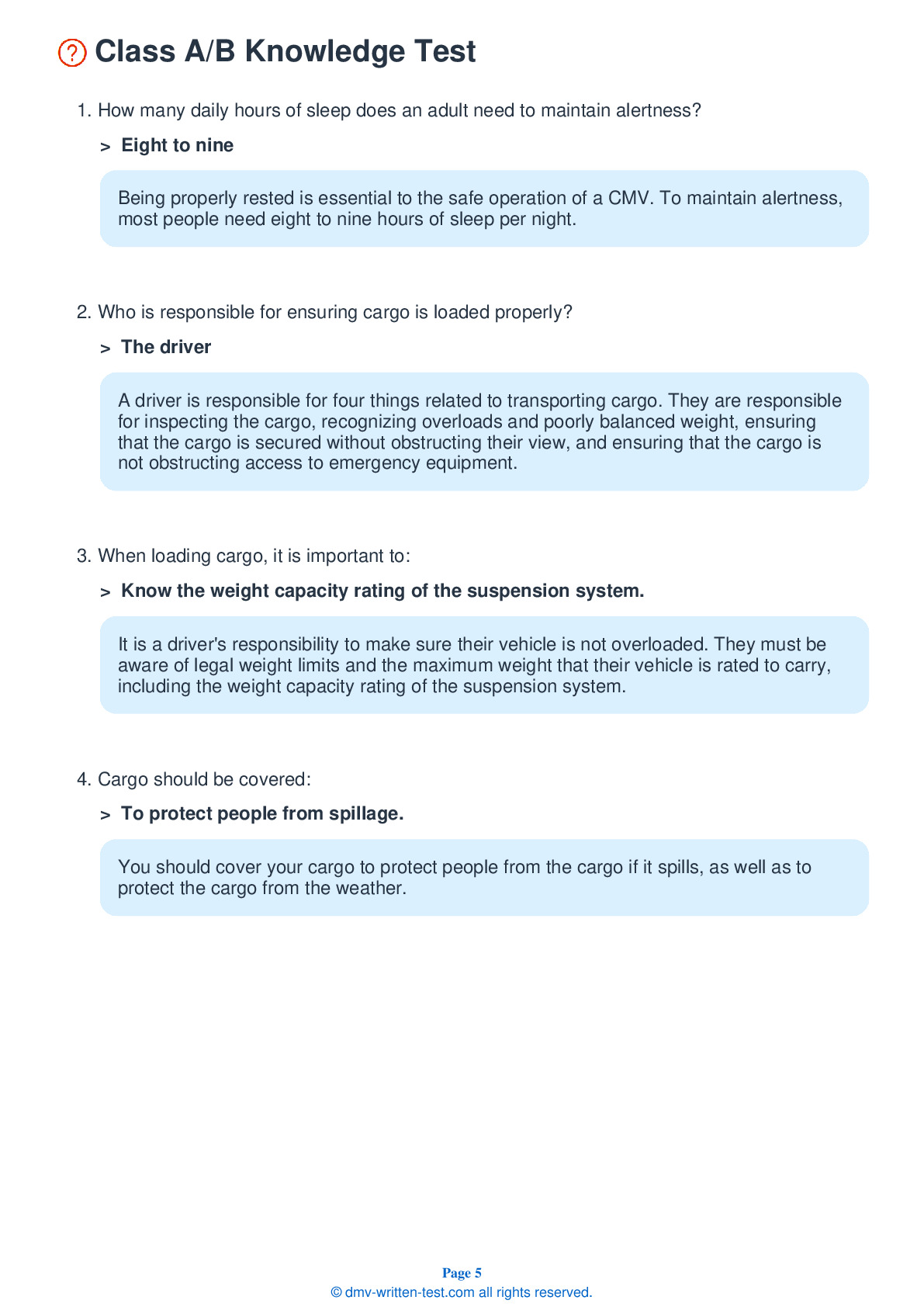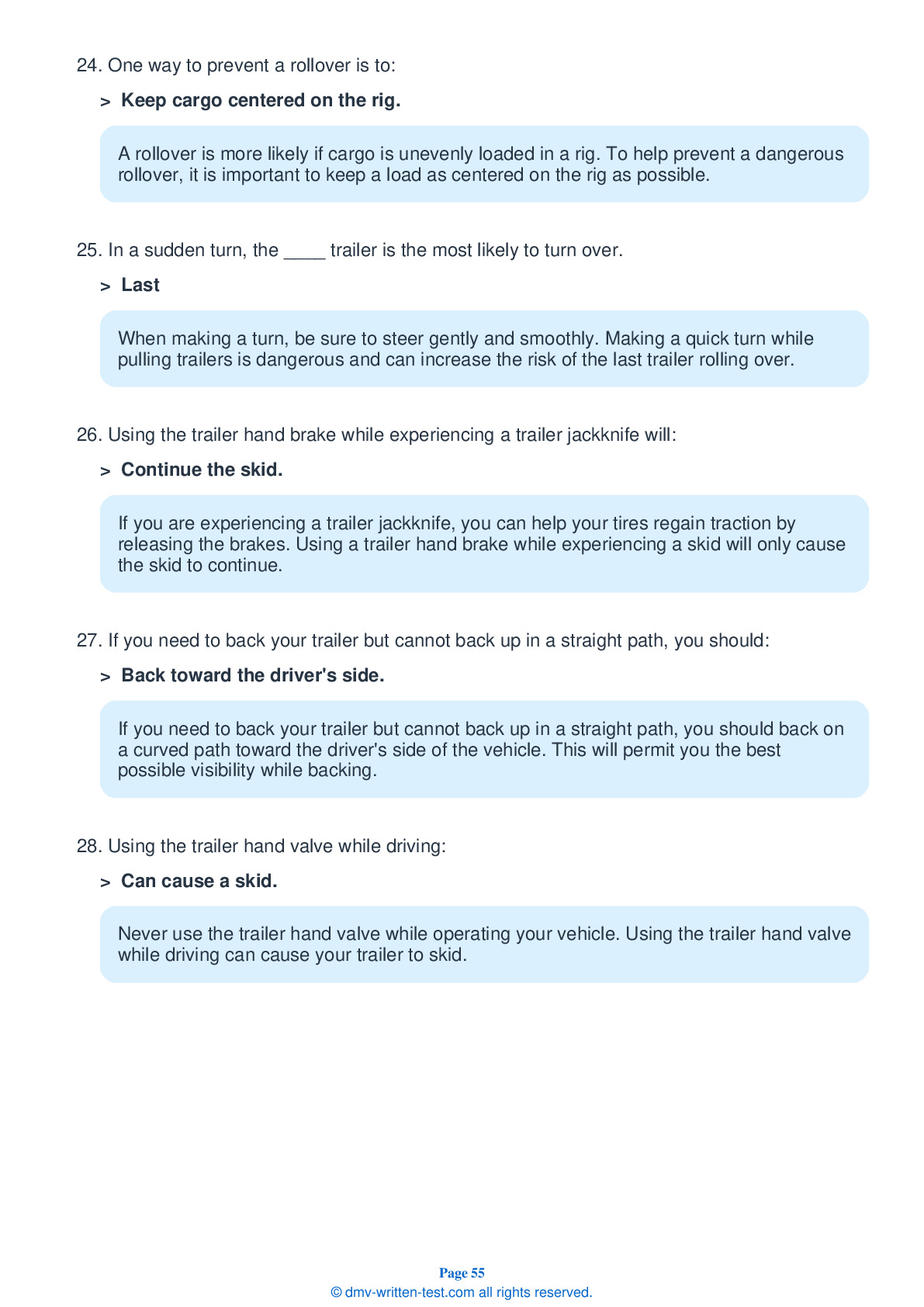Knowledge Test Class B
This license is required for driving a single vehicle with a GVWR of more than 26,001 pounds, and a trailer not to exceed 10,000 pounds gross vehicle weight rating, or a vehicle designed to transport 24 or more people (including the driver). To receive this license, applicants must pass a 50-question test. To pass, applicants must answer 40 questions correctly. Each question has three or four possible answer choices. Test questions come from the Connecticut Commercial Driver License Manual. Questions come from chapters covering: Introduction, Driving Safely, Transporting Cargo Safely, Air Brakes (if applicable), Pre-Trip Vehicle Inspection Test, Basic Vehicle Control Skills Test and On-Road Driving.. Endorsements that may be used with a Class B CDL are: Hazardous materials, Tank, Passenger, HazMat and Tank, Air Brakes and School bus.
8. Which of the following is not part of a vehicle’s air brake system?
Components of an air brake system include an air compressor, an air compressor governor, air storage tanks, air tank drains, an alcohol evaporator, a safety valve, a brake pedal, foundation brakes, supply pressure gauges, an application pressure gauge, a low air pressure warning signal, a stop light switch, a front brake limiting valve (on some older vehicles), spring brakes, and parking brake controls.
9. To avoid becoming an aggressive driver, you should:
To avoid becoming an aggressive driver, begin a trip with realistic expectations of how long the trip will take, allowing extra time for traffic delays. Do not tailgate other vehicles. To avoid upsetting other drivers, do not drive slowly in the left lane and do not gesture at the drivers (even in seemingly minor ways, like shaking your head).
10. During a static leakage test, what is the maximum leakage rate that is safe for a double combination vehicle?
When performing a static leakage test on a double combination vehicle with air brakes, the leakage rate should be no more than 3 psi in one minute. If the air leaks from the air brake system at a quicker rate, the vehicle should not be driven because something likely needs to be repaired.
11. Both systems in a dual air brake systems share:
Both systems in a dual air brake system share a single air compressor. If the air compressor is damaged, neither system will be able to operate properly.
12. Most heavy-duty vehicles use:
Most heavy-duty vehicles use dual air brake systems. A dual system has two separate air brake systems with a single set of controls.
13. If convicted of speeding while operating your personal automobile in a different jurisdiction, you should:
If you are convicted of any kind of traffic violation, in any type of vehicle, you must notify your employer within 30 days. You must also inform your motor vehicle licensing agency of the violation within 30 days if the conviction happened in another jurisdiction. This rule does not apply to parking infractions.
14. Before beginning to drive downhill, you should:
To avoid overusing your brakes, you should always shift into a lower gear before starting down a hill.
Frequently Asked Questions
1. Obtain a learner's permit: To apply for a learner's permit, you must be at least 18 years old and have a valid Connecticut driver's license. You must also pass a vision test and knowledge test specific to commercial vehicles.
2. Practice driving: While holding your learner's permit, you must practice driving with someone who has a valid Class B CDL and has held it for at least two years.
3. Schedule and pass the skills test: The skills test consists of three parts: pre-trip inspection, basic vehicle control skills, and on-road driving. You must bring your own vehicle that meets the requirements for the test.
4. Submit required documents: After passing the skills test, you must submit required documents, including proof of identity, residency, and citizenship or legal presence in the United States.
5. Pay required fees: You must pay the required fees for your Class B CDL.
Once you have completed these steps, you will receive your Class B CDL in Connecticut and will be authorized to operate commercial vehicles within the weight limits described above.
Some examples of vehicles you can operate with a Class B CDL include:
- Straight trucks (such as delivery trucks)
- Large buses (such as school buses or city buses)
- Dump trucks
- Cement mixers
- Tow trucks (with a gross vehicle weight rating of over 10,000 pounds)
- Box trucks
- Refrigerated trucks
It's important to note that there may be additional endorsements required depending on the specific type of vehicle you are operating. For example, if you are operating a bus with passengers, you may need to obtain a passenger endorsement.
1. Age: You must be at least 18 years old to obtain a Class B CDL. If you will be crossing state lines or hauling hazardous materials, you must be at least 21 years old.
2. Valid Connecticut driver's license: You must have a valid Connecticut driver's license.
3. Medical certification: You must pass a medical examination and obtain a medical certificate from a certified medical examiner.
4. Knowledge test: You must pass a written knowledge test specific to commercial vehicles.
5. Skills test: You must pass a skills test consisting of three parts: pre-trip inspection, basic vehicle control skills, and on-road driving.
6. Required documents: You must provide the required documents, such as proof of identity, residency, and citizenship or legal presence in the United States.
7. Fees: You must pay the required fees for your Class B CDL.
It's important to note that if you have any prior driving violations or criminal convictions, they may impact your ability to obtain a Class B CDL license. Additionally, some endorsements may require additional testing or qualifications.
It's important to note that some employers may have their own age requirements for certain driving positions, even if you meet the state's minimum age requirement for a Class B CDL. Additionally, some endorsements may have higher age requirements. It's always a good idea to check with your employer or the Connecticut Department of Motor Vehicles (DMV) for specific age requirements related to your desired driving position or endorsement.
Here are some of the common endorsements for a Class B CDL:
1. Passenger endorsement (P): Required to operate a commercial vehicle designed to transport 16 or more passengers, including the driver.
2. School bus endorsement (S): Required to operate a school bus.
3. Tanker endorsement (N): Required to operate a commercial vehicle that transports liquid or gaseous materials in tanks.
4. Hazardous materials endorsement (H): Required to transport hazardous materials as defined by federal law.
5. Air brakes endorsement (L): Required to operate a commercial vehicle with air brakes.
It's important to note that some endorsements may require additional testing or qualifications beyond the standard Class B CDL requirements. Before applying for your Class B CDL, make sure to determine which endorsements, if any, you need based on your desired driving position and cargo.
1. Pre-trip inspection: This portion of the test evaluates your ability to inspect the vehicle for safety defects and check that all systems are in proper working order.
2. Basic vehicle control: This portion of the test evaluates your ability to control the vehicle in a variety of maneuvers, such as backing up, turning, and parking.
3. On-road driving: This portion of the test evaluates your ability to safely operate the vehicle on public roads and highways, including merging, changing lanes, and obeying traffic signals and signs.
During the skills test, you will be graded on your ability to complete each portion of the test safely and effectively. You will also be expected to follow all applicable traffic laws and regulations.
It's important to note that each state may have slightly different requirements for the Class B CDL skills test. Make sure to check with your state's Department of Motor Vehicles (DMV) for specific details about their testing requirements and procedures.
1. Passenger restrictions: If you have a Class B CDL with a passenger endorsement (P), you may be restricted from carrying more than a certain number of passengers (usually 16 or fewer).
2. Air brake restrictions: If you took the skills test in a vehicle without air brakes, your license will be restricted to vehicles without air brakes.
3. Hazardous materials restrictions: If you did not pass the hazardous materials endorsement (H) test, you will be restricted from transporting hazardous materials.
4. Tank vehicle restrictions: If you did not pass the tank vehicle endorsement (N) test, you will be restricted from operating tank vehicles.
5. Nighttime driving restrictions: Some states may restrict new drivers with a Class B CDL from driving at night until they gain more experience.
It's important to note that these restrictions may vary by state and depend on the specific endorsements you hold. Make sure to check with your state's Department of Motor Vehicles (DMV) for specific details about any restrictions or limitations on your Class B CDL.
If you need a language interpreter during the road skills test or pre-trip inspection test, you must provide your own interpreter or use a DMV-approved interpreter service.
Make sure to check with your state's Department of Motor Vehicles (DMV) for specific details about language options for the Class B CDL written test and any requirements for interpreters during the road skills test or pre-trip inspection test.
To request accommodations, you will need to fill out the Request for Examination Accommodations form provided by the DMV. The form requires you to provide information about your disability and the specific accommodations you need. You may also need to provide documentation from a qualified professional (such as a doctor or psychologist) that supports your request for accommodations.
Examples of accommodations that may be provided include extra time to complete the test, a separate testing room, or a reading aloud of the test questions.
Once you have submitted your request for accommodations, the DMV will review your request and provide a decision within 15 business days. If your request is approved, the DMV will work with you to schedule a date and time for your exam with the requested accommodations.
It's important to note that requests for accommodations should be made as early as possible, as it may take some time for the DMV to review and approve your request.
The waiting period for retaking the test will depend on the number of times you have failed the test previously. If it's your first time failing, you can retake the test as soon as the next business day. If it's your second or third time failing, you must wait 14 days before you can retake the test. If you fail the test four or more times, you must wait 30 days before retaking it.
It's important to note that each time you retake the test, you will need to pay a fee. In Connecticut, the fee for retaking a knowledge test is $10 per attempt.
If you're having difficulty passing the written test, it may be helpful to study more thoroughly and consider taking a practice test beforehand. You may also want to consider enrolling in a CDL training program to improve your chances of passing both the written and road skills tests.




